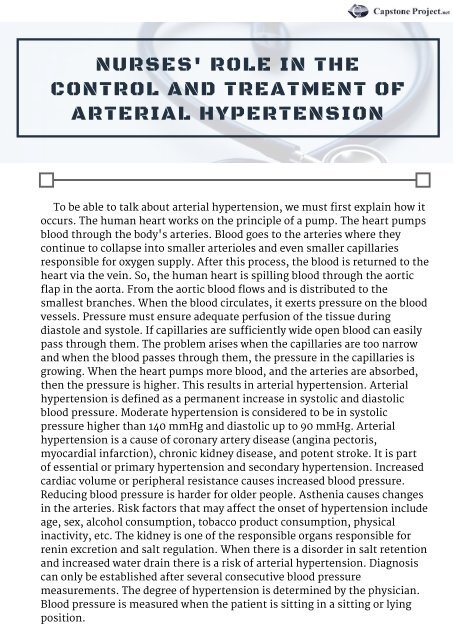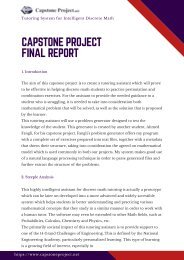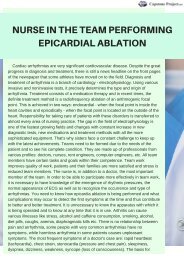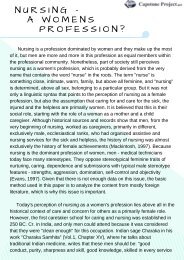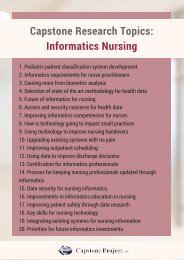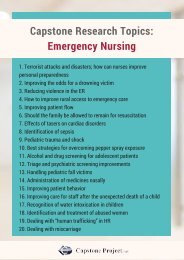Sample of DNP Capstone Project
Hi! Take a look at this article with professional sample of DNP capstone project. https://www.capstoneproject.net/our-capstone-projects/nursing-capstone-project/
Hi! Take a look at this article with professional sample of DNP capstone project. https://www.capstoneproject.net/our-capstone-projects/nursing-capstone-project/
Create successful ePaper yourself
Turn your PDF publications into a flip-book with our unique Google optimized e-Paper software.
NURSES' ROLE IN THE<br />
CONTROL AND TREATMENT OF<br />
ARTERIAL HYPERTENSION<br />
To be able to talk about arterial hypertension, we must first explain how it<br />
occurs. The human heart works on the principle <strong>of</strong> a pump. The heart pumps<br />
blood through the body's arteries. Blood goes to the arteries where they<br />
continue to collapse into smaller arterioles and even smaller capillaries<br />
responsible for oxygen supply. After this process, the blood is returned to the<br />
heart via the vein. So, the human heart is spilling blood through the aortic<br />
flap in the aorta. From the aortic blood flows and is distributed to the<br />
smallest branches. When the blood circulates, it exerts pressure on the blood<br />
vessels. Pressure must ensure adequate perfusion <strong>of</strong> the tissue during<br />
diastole and systole. If capillaries are sufficiently wide open blood can easily<br />
pass through them. The problem arises when the capillaries are too narrow<br />
and when the blood passes through them, the pressure in the capillaries is<br />
growing. When the heart pumps more blood, and the arteries are absorbed,<br />
then the pressure is higher. This results in arterial hypertension. Arterial<br />
hypertension is defined as a permanent increase in systolic and diastolic<br />
blood pressure. Moderate hypertension is considered to be in systolic<br />
pressure higher than 140 mmHg and diastolic up to 90 mmHg. Arterial<br />
hypertension is a cause <strong>of</strong> coronary artery disease (angina pectoris,<br />
myocardial infarction), chronic kidney disease, and potent stroke. It is part<br />
<strong>of</strong> essential or primary hypertension and secondary hypertension. Increased<br />
cardiac volume or peripheral resistance causes increased blood pressure.<br />
Reducing blood pressure is harder for older people. Asthenia causes changes<br />
in the arteries. Risk factors that may affect the onset <strong>of</strong> hypertension include<br />
age, sex, alcohol consumption, tobacco product consumption, physical<br />
inactivity, etc. The kidney is one <strong>of</strong> the responsible organs responsible for<br />
renin excretion and salt regulation. When there is a disorder in salt retention<br />
and increased water drain there is a risk <strong>of</strong> arterial hypertension. Diagnosis<br />
can only be established after several consecutive blood pressure<br />
measurements. The degree <strong>of</strong> hypertension is determined by the physician.<br />
Blood pressure is measured when the patient is sitting in a sitting or lying<br />
position.
The measurement should be repeated several days in order to diagnose<br />
arterial hypertension. Once the pressure is measured it is necessary to write<br />
down and inform the patient and the physician. The biggest option for action<br />
here there is a patrons who have the opportunity to visit the patient at home<br />
and identify the risk factors for the onset <strong>of</strong> hypertension. The cuff and arm<br />
must be at the height <strong>of</strong> the heart. Blood pressure in most people begins<br />
between 35 and 45 years. Symptoms appear inconspicuously for what it is<br />
start with treatment early on. Treatment <strong>of</strong> arterial hypertension is carried<br />
out with antihypertensive and by changing the style <strong>of</strong> life. The most<br />
common antihypertensive agents are β-blockers, calcium channel blockers,<br />
ACE inhibitors, angiotensin receptor blockers. It is <strong>of</strong>ten necessary to use 2<br />
or more antihypertensive to achieve target arterial pressure below 140/ 90<br />
mmHg. AH is the leading public health problem. In Croatia, AH is more<br />
common in women than in men. The nurse deserves to educate the patient<br />
about hypertension itself, education about the risks that exist and how to<br />
avoid them and what causes them. She is in charge <strong>of</strong> supporting the patient<br />
and her family in changing the style <strong>of</strong> life. Surgical diagnoses that occur<br />
most frequently with the diagnosis <strong>of</strong> arterial hypertension include<br />
incontinence, anxiety, acute pain, obesity, reduced fatigue.<br />
AH in today is one <strong>of</strong> the leading issues and is the main factor increasing<br />
the risk <strong>of</strong> cardiovascular, cerebrovascular and renal diseases. The greatest<br />
challenge for healthcare pr<strong>of</strong>essionals is education <strong>of</strong> patients on the health<br />
consequences <strong>of</strong> arterial hypertension, and on ways <strong>of</strong> proper control and the<br />
implementation <strong>of</strong> procedures for lowering blood pressure. According to the<br />
latest classification criteria <strong>of</strong> 2007 ESH - ESC under the concept <strong>of</strong> arterial<br />
hypertension implies blood pressure in values greater than 140/90 mmHg,<br />
measured by the calibrated live blood pressure monitor in the clinic.<br />
In the elderly, it is harder to achieve AT values <strong>of</strong> less than 140/ 90 and<br />
synergistic hypertension is isolated. By treating AH in older people, it not<br />
only reduces the mortality rate but also the total mortality rate. The<br />
American Society for Hypertension introduces a new term:<br />
"prehypertension", which implies systolic pressure ranging from 120 mmHg<br />
to 139 mmHg, and a diastolic pressure <strong>of</strong> 80 mmHg to 89 mmHg. According<br />
to ESH - ESC people are divided into two groups. One group includes people<br />
with normal blood pressure, and the other group with high normal blood<br />
pressure. These two groups <strong>of</strong> people are distinguished by the fact that<br />
people with high normal blood pressure have an increased risk for STD if<br />
there are still associated diseases. Such a group <strong>of</strong> patients requires therapy,<br />
which is not the case with people with normal pressure. Apart from therapy,<br />
in such patients with "prehypertension" it is important to change the way <strong>of</strong><br />
life that can significantly affect blood pressure.
Treatment <strong>of</strong> arterial hypertension can be performed by medication and by<br />
changing the style <strong>of</strong> life. Medication includes antihypertensive drugs that<br />
are recommended for a high-risk hypertonic group. The decision on whether<br />
a patient should start a medication treatment depends on the values <strong>of</strong><br />
systolic and diastolic pressure and other risk factors. If the patient has blood<br />
pressure higher than 140/90 mmHg, and the pressure is measured for several<br />
consecutive days then such a patient is a candidate for antihypertensive<br />
treatment. The goal <strong>of</strong> treating AH is to reduce the risk factors for<br />
cardiovascular disease and reduce the blood pressure below 130/80. MmHg.<br />
With medical treatment, the role <strong>of</strong> a nurse is also helping the patient to<br />
change their lifestyle and controlling other risk factors.<br />
The nurse's task is to identify the risks <strong>of</strong> developing cardiovascular<br />
disease and to act preventively. In the present-day population, younger<br />
generations go into bad habits like smoking, drinking alcoholic beverages,<br />
and entering high-calorie foods (fast foods). Together with the patient, the<br />
nurse must determine the degree <strong>of</strong> risk <strong>of</strong> developing cardiovascular<br />
disease, analyze harmful habits, and encourage it to change the life style.<br />
Changes that the patient has to spend in his daily life include smoking<br />
cessation, reduced body weight (controlled diets), reduced salt intake,<br />
increased body activity, increased intake <strong>of</strong> fruit and vegetables, and reduced<br />
saturated intake and decreased total fat intake. A nurse needs to educate the<br />
patient about the importance <strong>of</strong> life-style changes that can help lower<br />
hereditary hypertension. It is necessary to encourage the patient to take<br />
antihypertensive drugs, educate him on blood pressure self-control and<br />
control the body weight. The same education <strong>of</strong> the patient depends on the<br />
character <strong>of</strong> the same patient, about his cognitive abilities, his age, and the<br />
conditions in which he lives and about the motivation to heal. Patients with<br />
weaker cognitive characteristics will weaker and slower to learn how to<br />
regulate their diet. Nurse diagnosis is used by nurses to define a current or<br />
potential health problem that they are authorized to treat according to their<br />
intended purpose. Sister diagnosis is formulated by PES model, which<br />
indicates (P) problem, (E) etiology, and (S) symptom. The benefits <strong>of</strong> using<br />
nurse diagnosis are to facilitate communication between healthcare<br />
pr<strong>of</strong>essionals and serve as evidence for their sister work. Among the most<br />
common diagnoses that arise with arterial hypertension are anxiety, obesity,<br />
unavailability, high risk for reduced fatigue and acute pain. Anxiety occurs in<br />
patients who may not be well educated in order to cure arterial hypertension.<br />
It can be reported at the beginning <strong>of</strong> knowledge about the illness. One <strong>of</strong> the<br />
reasons for obesity is ignoring the calorific value <strong>of</strong> certain foods. A high risk<br />
<strong>of</strong> reduced fatigue is reported in very obese patients who are at risk <strong>of</strong><br />
cardiovascular disease. With the acute pain that may appear in the chest, a<br />
person may have frequent headaches.
To be able to talk about arterial hypertension, we must first explain how it<br />
occurs. The human heart works on the principle <strong>of</strong> a pump. The heart pumps<br />
blood through the body's arteries. Blood goes to the arteries where they<br />
continue to collapse into smaller arterioles and even smaller capillaries<br />
responsible for oxygen supply. After this process, the blood is returned to the<br />
heart via the vein. So, the human heart is spilling blood through the aortic<br />
flap in the aorta. From the aortic blood flows and is distributed to the<br />
smallest branches. When the blood circulates, it exerts pressure on the blood<br />
vessels. Pressure must ensure adequate perfusion <strong>of</strong> the tissue during<br />
diastole and systole. If capillaries are sufficiently wide open blood can easily<br />
pass through them. The problem arises when the capillaries are too narrow<br />
and when the blood passes through them, the pressure in the capillaries is<br />
growing. When the heart pumps more blood, and the arteries are absorbed,<br />
then the pressure is higher. This results in arterial hypertension. Arterial<br />
hypertension is defined as a permanent increase in systolic and diastolic<br />
blood pressure. Moderate hypertension is considered to be in systolic<br />
pressure higher than 140 mmHg and diastolic up to 90 mmHg. Arterial<br />
hypertension is a cause <strong>of</strong> coronary artery disease (angina pectoris,<br />
myocardial infarction), chronic kidney disease, and potent stroke. It is part<br />
<strong>of</strong> essential or primary hypertension and secondary hypertension. Increased<br />
cardiac volume or peripheral resistance causes increased blood pressure.<br />
Reducing blood pressure is harder for older people. Asthenia causes changes<br />
in the arteries. Risk factors that may affect the onset <strong>of</strong> hypertension include<br />
age, sex, alcohol consumption, tobacco product consumption, physical<br />
inactivity, etc. The kidney is one <strong>of</strong> the responsible organs responsible for<br />
renin excretion and salt regulation. When there is a disorder in salt retention<br />
and increased water drain there is a risk <strong>of</strong> arterial hypertension. Diagnosis<br />
can only be established after several consecutive blood pressure<br />
measurements. The degree <strong>of</strong> hypertension is determined by the physician.<br />
Blood pressure is measured when the patient is sitting in a sitting or lying<br />
position.
REFERENCES<br />
1. Heneghan, C., Perera, R., Mant, D. & Glasziou, P. (2007). Hypertension<br />
Guideline Recommendations in General Practice: Awareness, Agreement,<br />
Adoption, and Adherence. Br. J. Gen. Pract., 57, 948 - 52.<br />
.<br />
2. Kearney, P. M., Whelton, M., Reynolds, K., Muntner, P., Whelton, P. K. &<br />
He, J. (2005). Global Burden <strong>of</strong> Hypertension: Analysis <strong>of</strong> Worldwide Data.<br />
Lancet., 365, 217 - 23.<br />
3. James, P.A., Oparil, S. & Carter, B. L. (2014). Evidence- Based Guideline for<br />
the Management <strong>of</strong> High Bood Pressure in Adults: Report from the Panel<br />
Members Appointed to the Eighth Joint National Committee (JNC 8) JAMA,<br />
311, 507 - 520.<br />
4. Phillips, L. S., Branch, W. T., Cook, C. B., Doyle, J. P., El Kebbi, I. M. &<br />
Gallina, D. L. (2001). Clinical Inertia. Ann. Intern. Med., 135, 825 - 34.<br />
5. Oakeshott, P., Kerry, S., Austin, A. & Cappuccio, F. (2003). Is There a Role<br />
for Nurse-led Blood Pressure Management in Primary Care? Fam. Pract., 20,<br />
469 - 73.


